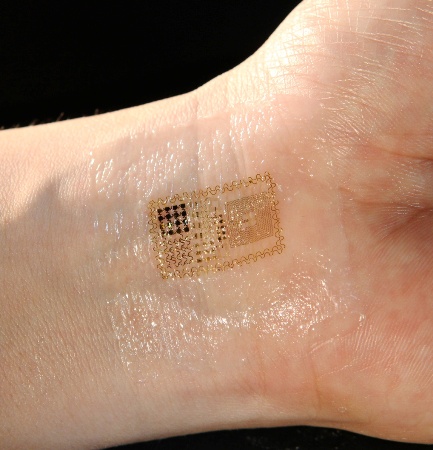Researchers at the University of Illinois at Urbana-Champaign have developed electronic skin patches that can be used for wireless diagnosis of health problems or for providing treatment. The study was presented at the American Chemical Society’s (ACS) 243rd National Meeting & Exposition in San Diego, California.
 “Electronic skin” patches could provide on-the-go medical care. Credit: John Rogers, Ph.D.
“Electronic skin” patches could provide on-the-go medical care. Credit: John Rogers, Ph.D.
Patients undergo electrocardiograms, electromyograms and electroencephalograms for checking the health of their hearts, muscles and brains. This involves staying tethered to diagnostic machines in hospitals or clinics for long hours. Pins, wires, tapes and gels that are used during these procedures may cause pain or leave a residue when removed. These tests are carried out in a medical setting.
The novel “electronic skin” patches can be used for non-invasive monitoring of heart, muscle and brain activity, while carrying out normal, everyday activities. These patches are transferred to the skin with water and spray-on bandages are applied over the patch to protect the circuit. The devices allow sweat, transpiration and washing. They do not require any pins, wires, tapes or gels. These patches pack full-scale electronic circuits within their microscopic dimensions. They have the thickness of a human hair.
These patches are flexible and stretchable. They move along with the normal skin movements. Silicon-based wafers used in the electronics industry are hard and brittle materials. In order to make them stretch and bend, the researchers used very small pieces of the material in a wavy pattern. This avoided potential stress or strain that may lead to fracture or cracks in the material.
The electronic patches have also been applied on medical instruments, including catheters that can be inserted into the body. They help take measurements during surgical procedures.
The devices also function in a bi-directional manner. The latest patches have the capability to measure muscle activity and also stimulate the muscles. The researchers intend to add wireless capabilities that will enable transfer of data to the doctor and to the patient’s cell phone.